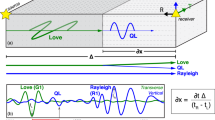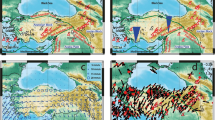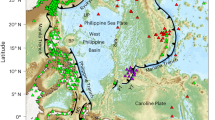Abstract
Seismologists have begun to recognize that the upper mantle at depth is anisotropic and that seismological data are not fully explicable if anisotropy is ignored1–5. On entering an anisotropic zone a plane shear wave splits into two orthogonally polarized phases6; an effect observed by several researchers7, notably by Ando et al.5,8,9. The near vertical ScS wave, an S wave reflected once at the core-mantle boundary, is one of the most suitable phases to study the phenomenon of shear wave birefringence because it is isolated from other phases and because its particle motion is nearly horizontal and thus free from S to P conversion. The split ScS shear waves travel with different velocities in the anisotropic zone and consequently there is a time delay between their arrival at stations. My aim was to determine this time delay and the azimuth of polarization using the ScS records of two horizontal components from the Japanese islands for a deep shock beneath the Sea of Okhotsk. From the total of 41 stations 34 show a polarization of the maximum velocity phase in the NNW–SSE direction with an average time advance of ∼0.8s from the minimum velocity phase. The relevant anisotropic zone seems to be deep-seated.
This is a preview of subscription content, access via your institution
Access options
Subscribe to this journal
Receive 51 print issues and online access
$199.00 per year
only $3.90 per issue
Buy this article
- Purchase on Springer Link
- Instant access to full article PDF
Prices may be subject to local taxes which are calculated during checkout
Similar content being viewed by others
References
Shimamura, H., Asada, T., Suehiro, K., Yamada, T. & Inatani, H. Phys. Earth planet. Inter. 31, 348–362 (1983).
Fuchs, K. Phys. Earth planet. Inter. 31, 93–118 (1983).
Anderson, D. L. & Dziewonski, A. M. Geophys. J. R. astr. Soc. 69, 383–404 (1982).
Anderson, D. L. & Regan, J. Geophys. Res. Lett. 10, 841–844 (1983).
Ando, M., Ishikawa, Y. & Wada, H. Nature 268, 43–46 (1980).
Crampin, S. & Kirkwood, S. C. J. Geophys. 49, 35–42 (1981).
Crampin, S. et al. Nature 286, 874–877 (1980).
Ando, M. & Ishikawa, Y. J. Phys. Earth. 30, 191–199 (1982).
Ando, M, Ishikawa, H. & Yamazaki, F. J. geophys. Res. 88, 5850–5864 (1983).
Stauder, W. & Mualchin, L. J. geophys. Res. 81, 297–308 (1976).
Author information
Authors and Affiliations
Rights and permissions
About this article
Cite this article
Fukao, Y. Evidence from core-reflected shear waves for anisotropy in the Earth's mantle. Nature 309, 695–698 (1984). https://doi.org/10.1038/309695a0
Received:
Accepted:
Issue Date:
DOI: https://doi.org/10.1038/309695a0
This article is cited by
-
Shear wave birefringence and current configuration of active tectonics of Shillong plateau: an appraisal of Indian plate motion and regional structures
International Journal of Earth Sciences (2022)
-
Crustal structure and upper mantle anisotropy of the Afar triple junction
Earth, Planets and Space (2021)
-
Seismic anisotropy accrued by seven unusually deep local earthquakes (between 50 and 60 km) in the Albertine Rift: implications of asthenospheric melt upwelling
Journal of Seismology (2021)
-
Evidence of heterogeneous and unstable anisotropic settings beneath the Northeast Indian lithosphere from characterization of null splitting measurements
Acta Geophysica (2021)
-
Upper mantle seismic anisotropy beneath the Kachchh rift zone, Gujarat, India, from shear wave splitting analysis
Journal of Earth System Science (2020)
Comments
By submitting a comment you agree to abide by our Terms and Community Guidelines. If you find something abusive or that does not comply with our terms or guidelines please flag it as inappropriate.



